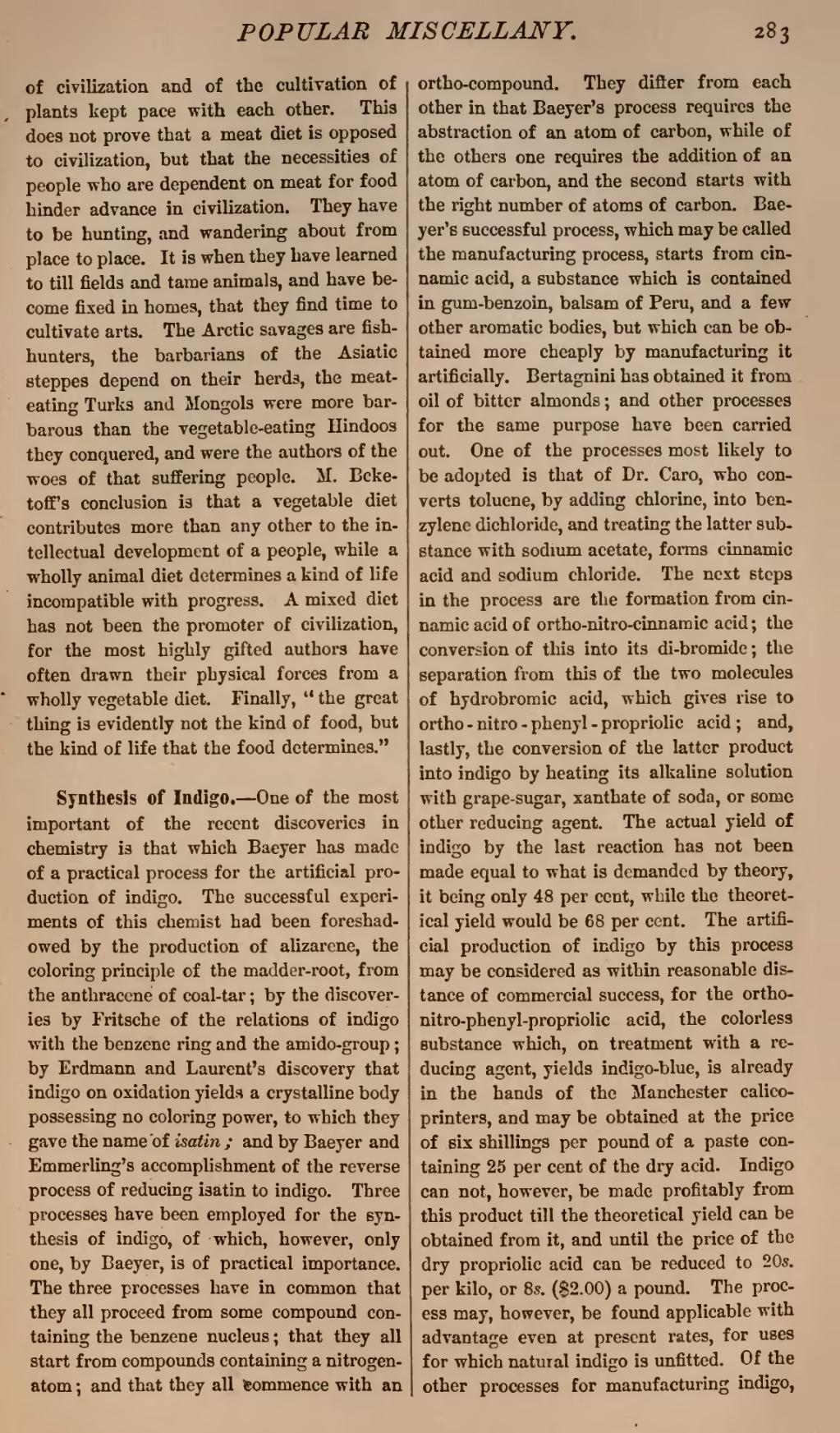of civilization and of the cultivation of plants kept pace with each other. This does not prove that a meat diet is opposed to civilization, but that the necessities of people who are dependent on meat for food hinder advance in civilization. They have to be hunting, and wandering about from place to place. It is when they have learned to till fields and tame animals, and have become fixed in homes, that they find time to cultivate arts. The Arctic savages are fish hunters, the barbarians of the Asiatic steppes depend on their herds, the meat eating Turks and Mongols were more barbarous than the vegetable-eating Hindoos they conquered, and were the authors of the woes of that suffering people, M. Beketoff's conclusion is that a vegetable diet contributes more than any other to the intellectual development of a people, while a wholly animal diet determines a kind of life incompatible with progress. A mixed diet has not been the promoter of civilization, for the most highly gifted authors have often drawn their physical forces from a wholly vegetable diet. Finally, "the great thing is evidently not the kind of food, but the kind of life that the food determines."
Synthesis of Indigo.—One of the most important of the recent discoveries in chemistry is that which Baeyer has made of a practical process for the artificial production of indigo. The successful experiments of this chemist had been foreshadowed by the production of alizarene, the coloring principle of the madder-root, from the anthracene of coal-tar; by the discoveries by Fritsche of the relations of indigo with the benzene ring and the amido-group; by Erdmann and Laurent's discovery that indigo on oxidation yields a crystalline body possessing no coloring power, to which they gave the name of isatin; and by Baeyer and Emmerling's accomplishment of the reverse process of reducing isatin to indigo. Three processes have been employed for the synthesis of indigo, of which, however, only one, by Baeyer, is of practical importance. The three processes have in common that they all proceed from some compound containing the benzene nucleus; that they all start from compounds containing a nitrogen atom; and that they all Commence with an ortho-compound. They differ from each other in that Baeyer's process requires the abstraction of an atom of carbon, while of the others one requires the addition of an atom of carbon, and the second starts with the right number of atoms of carbon. Baeyer's successful process, which may be called the manufacturing process, starts from cinnamic acid, a substance which is contained in gum-benzoin, balsam of Peru, and a few other aromatic bodies, but which can be obtained more cheaply by manufacturing it artificially. Bertagnini has obtained it from oil of bitter almonds; and other processes for the same purpose have been carried out. One of the processes most likely to be adopted is that of Dr. Caro, who converts toluene, by adding chlorine, into benzylene dichloride, and treating the latter substance with sodium acetate, forms cinnamic acid and sodium chloride. The next steps in the process are the formation from cinnamic acid of ortho-nitro-cinnamic acid; the conversion of this into its di-bromide; the separation from this of the two molecules of hydrobromic acid, which gives rise to ortho-nitro-phenyl-propriolic acid; and, lastly, the conversion of the latter product into indigo by heating its alkaline solution with grape-sugar, xanthate of soda, or some other reducing agent. The actual yield of indigo by the last reaction has not been made equal to what is demanded by theory, it being only 48 per cent, while the theoretical yield would be 68 per cent. The artificial production of indigo by this process may be considered as within reasonable distance of commercial success, for the orthonitro-phenyl-propriolic acid, the colorless substance which, on treatment with a reducing agent, yields indigo-blue, is already in the hands of the Manchester calico printers, and may be obtained at the price of six shillings per pound of a paste containing 25 per cent of the dry acid. Indigo can not, however, be made profitably from this product till the theoretical yield can be obtained from it, and until the price of the dry propriolic acid can be reduced to 20s. per kilo, or 8s. ($2.00) a pound. The process may, however, be found applicable with advantage even at present rates, for uses for which natural indigo is unfitted. Of the other processes for manufacturing indigo,
